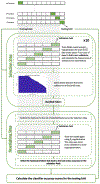Chained regularization for identifying brain patterns specific to HIV infection
- PMID: 30138676
- PMCID: PMC6197908
- DOI: 10.1016/j.neuroimage.2018.08.022
Chained regularization for identifying brain patterns specific to HIV infection
Abstract
Human Immunodeficiency Virus (HIV) infection continues to have major adverse public health and clinical consequences despite the effectiveness of combination Antiretroviral Therapy (cART) in reducing HIV viral load and improving immune function. As successfully treated individuals with HIV infection age, their cognition declines faster than reported for normal aging. This phenomenon underlines the importance of improving long-term care, which requires a better understanding of the impact of HIV on the brain. In this paper, automated identification of patients and brain regions affected by HIV infection are modeled as a classification problem, whose solution is determined in two steps within our proposed Chained-Regularization framework. The first step focuses on selecting the HIV pattern (i.e., the most informative constellation of brain region measurements for distinguishing HIV infected subjects from healthy controls) by constraining the search for the optimal parameter setting of the classifier via group sparsity (ℓ2,1-norm). The second step improves classification accuracy by constraining the parameterization with respect to the selected measurements and the Euclidean regularization (ℓ2-norm). When applied to the cortical and subcortical structural Magnetic Resonance Images (MRI) measurements of 65 controls and 65 HIV infected individuals, this approach is more accurate in distinguishing the two cohorts than more common models. Finally, the brain regions of the identified HIV pattern concur with the HIV literature that uses traditional group analysis models.
Keywords: Computational neuroscience; Group sparsity; Human immunodeficiency virus (HIV); MRI brain image analysis; Multiple kernel learning.
Copyright © 2018 Elsevier Inc. All rights reserved.
Figures









References
-
- Heaton RK, Franklin DR, Ellis RJ, McCutchan JA, Letendre SL, LeBlanc S, Corkran SH, Duarte NA, Clifford DB, Woods SP, et al., Hiv-associated neurocognitive disorders before and during the era of combination antiretroviral therapy: differences in rates, nature, and predictors, Journal of neurovirology 17 (1) (2011) 3–16. - PMC - PubMed
-
- Pfefferbaum A, Rosenbloom MJ, Sassoon SA, Kemper CA, Deresinski S, Rohlfing T, Sullivan EV, Regional brain structural dysmorphology in human immunodeficiency virus infection: effects of acquired immune deficiency syndrome, alcoholism, and age, Biological psychiatry 72 (5) (2012) 361–370. - PMC - PubMed
-
- Castelo J, Sherman S, Courtney M, Melrose R, Stern C, Altered hippocampal-prefrontal activation in hiv patients during episodic memory encoding, Neurology 66 (11) (2006) 1688–1695. - PubMed
Publication types
MeSH terms
Grants and funding
LinkOut - more resources
Full Text Sources
Other Literature Sources
Medical
Research Materials

